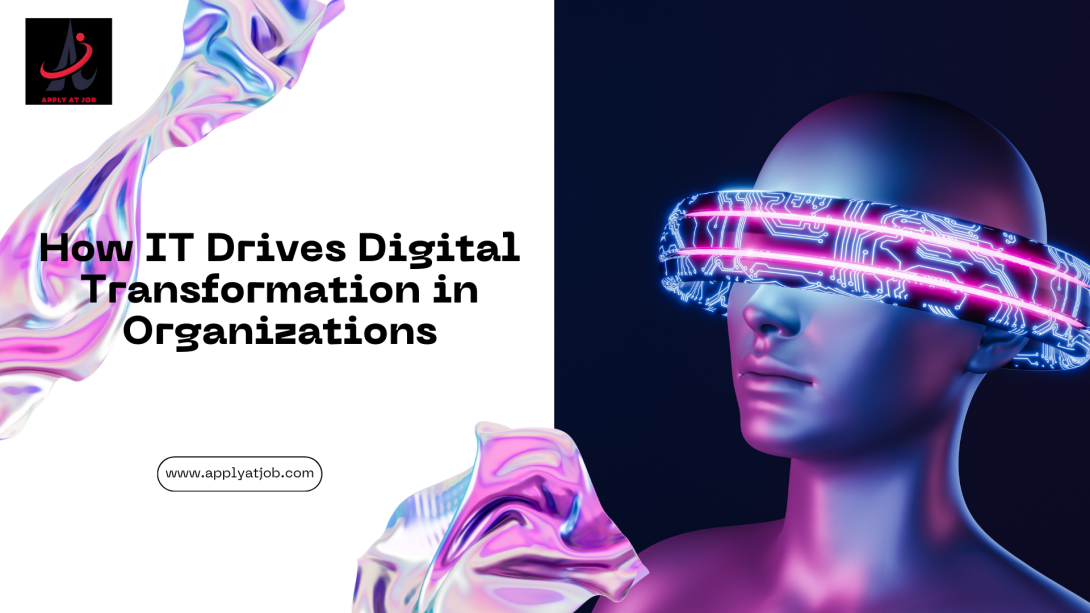
How IT Prompts Organizational Digital Transformation
Digital transformation is now a must for businesses in today's fast-paced business climate if they want to survive and grow in a market that is changing quickly. Information Technology is at the center of this change (IT). IT is essential to allowing and propelling digital transformation because it uses state-of-the-art technology, improves business procedures, and gives companies the ability to provide cutting-edge goods and services. In this blog, we'll look at the crucial role IT plays in accelerating digital transformation, the major technologies at play, and the ways in which companies can use IT to establish a digital-first culture that encourages development and innovation.
1. IT's Place in the Digital Revolution
The act of incorporating digital technology into every facet of an organization and radically altering how they function and provide value to clients is known as "digital transformation." Since IT offers the infrastructure, resources, and know-how required to modernize operations, streamline workflows, and enhance customer experiences, IT is the engine powering this shift.
Important functions of IT in the digital transition
. Modernizing Legacy Systems: IT is in charge of upgrading or swapping out antiquated systems with cutting-edge, cloud-based solutions that facilitate increased performance, scalability, and flexibility.
. IT provides businesses with cutting-edge: data analytics solutions that transform unstructured data into actionable insights, facilitating quicker and more intelligent decision-making.
. Improving Cooperation and Communication: IT puts in place digital platforms for collaboration and communication tools that let teams work together effectively, no matter where they are in the world. This promotes a workforce that is more nimble and connected.
. Driving Innovation: IT enables organizations to innovate, optimize processes, and improve customer experiences by implementing cutting-edge technologies like automation, machine learning, and artificial intelligence (AI).
2. Crucial Technologies Driving the Digital Revolution
IT teams are at the forefront of embracing and putting these tools to use in order to drive business change. Digital transformation is dependent on a variety of technologies. The major technologies that are facilitating digital transformation are listed below:
a) Cloud Processing
The foundation of digital transformation is cloud computing, which offers the scalability, flexibility, and affordability needed to update IT infrastructure. Organizations can store and handle massive quantities of data, quickly build apps, and scale resources up or down in response to demand by migrating to the cloud.
Cloud computing's advantages for digital transformation
. Scalability to manage workload fluctuations
. Cost-effectiveness by lowering the requirement for pricey on-site infrastructure
. Enhanced data security and disaster recovery capabilities
. quicker new product and service launch times
b) Complex Data and High-Level Analysis
The foundation of the digital transformation is data. IT teams use cutting-edge analytics platforms and tools to collect, examine, and understand vast volumes of data from several sources. Organizations may make better business decisions by utilizing big data to gather insightful knowledge about market trends, client behavior, and operational inefficiencies.
How digital transformation is fueled by big data:
. improves client experiences by offering individualized goods and services
. uses predictive analytics and real-time data to optimize internal procedures.
. finds new possibilities and trends to support innovation
c) Machine learning (ML) and artificial intelligence (AI)
By allowing predictive analytics, automating repetitive procedures, and providing tailored consumer experiences, AI and ML are revolutionizing IT operations. Artificial Intelligence (AI) is used by IT teams to boost client relations, streamline operations, and automate decision-making.
AI uses in the digital transition
. Virtual assistants and chatbots that offer round-the-clock client service
. predictive analytics that foretells consumer behavior and market tendencies
. Process automation that boosts productivity and decreases manual involvement
c) The Internet of Things
Massive volumes of data generated by IoT devices reveal real-time usage patterns for goods and services. IT plays a critical role in managing and safeguarding IoT environments, ensuring that data is gathered, processed, and used efficiently to promote innovation and increase operational efficiency.
IoT's influence on digital transformation:
. Customer service is improved via real-time data collecting from linked devices.
. Predictive maintenance for industrial and manufacturing processes
. goods and services that are more intelligent, responsive, and adjust to consumer demands
d) RPA, or robotic process automation
Businesses may automate rule-based, repetitive operations like data input, report production, and client onboarding with RPA. IT teams may lower the possibility of human mistake and free up staff time to concentrate on higher-value work by using RPA.
RPA in the process of going digital
. lowers operating expenses through the automation of repetitive operations
. increases the speed and accuracy of business operations
. increases adherence by guaranteeing uniform procedures
3. IT's Contribution to Improving Customer Experiences
Enhancing client experiences is one of the primary objectives of digital transformation. IT is essential to this because it implements platforms and technologies that let businesses better understand, interact with, and cater to their consumers.
The role of IT in improving customer experiences
. IT departments provide omnichannel customer platforms, which let companies communicate with clients easily across a variety of touchpoints, including websites, mobile applications, social media, and physical stores.
. Personalization: By evaluating consumer preferences and behavior to customize goods, services, and marketing initiatives, IT works with businesses to offer customized experiences using artificial intelligence (AI) and big data analytics.
. All the time: Chatbot assistance: Artificial intelligence (AI)-powered chatbots offer 24/7 customer service, addressing queries and resolving problems instantly to increase client happiness and cut down on wait times.
. Better User Experience (UX): IT departments strive to make digital platforms and interfaces as user-friendly, responsive, and intuitive as possible. This increases consumer engagement and retention.
4. Business Process Optimization Driven by IT
Digital transformation is about streamlining corporate operations to become more effective, flexible, and competitive—it's not simply about implementing new technology. IT is essential in determining how technology, analytics, and automation may enhance company processes.
Crucial areas for optimizing company processes are:
. Automation of Manual Tasks: By enabling the automation of tedious processes like order processing, reporting, and invoicing, IT may save expenses and increase accuracy.
. Process analytics: IT offers real-time business process monitoring and analysis solutions that support data-driven decision-making and ongoing process enhancement.
. Agile Development: IT facilitates the application of agile approaches, allowing teams to adapt swiftly to changes, iterate on products, and enhance continually in response to user input.
5. Using IT to Create a Digital-First Culture
Successful digital transformation necessitates a cultural shift in addition to technology. By encouraging the use of digital technologies, educating staff members, and supporting innovation, IT teams play a crucial part in creating a culture that prioritizes digitalization.
How IT support the culture of "digital first":
. Training and Support: To guarantee that staff members throughout the company feel at ease using new digital tools and technologies, IT departments offer training courses as well as continuous assistance.
. Collaboration Tools: IT puts into practice collaboration technologies such as Microsoft Teams, Zoom, and Slack, which facilitates teamwork across geographical boundaries.
. IT Fosters Innovation: By promoting the use of cloud platforms, APIs, and development tools that enable teams to swiftly prototype and implement innovative ideas, IT fosters a culture of experimentation.
Conclusion:
IT is the engine of digital transformation, allowing businesses to embrace new technologies, streamline operations, and improve client interactions. Through the use of automation, big data, cloud computing, artificial intelligence, and the Internet of Things, IT enables companies to innovate, grow, and prosper in the digital era.
Investing in IT capabilities is crucial for firms hoping to thrive in their digital transformation path. IT is essential to the expansion and long-term success of businesses, whether it is by updating antiquated systems, enhancing security, or encouraging a culture of digital innovation.
You can visit our site: Applyatjob.com
https://applyatjob.com/hiring-employee
https://applyatjob.com/jobs





